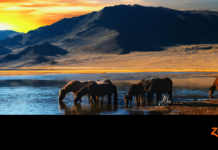 The National Reined Cow Horse Association (NRCHA) Snaffle Bit Futurity, which runs September 21 – October 5 in Reno, Nevada, celebrates its 39th anniversary this year, but the history of the unique working horse the Futurity was created for extends back hundreds of years.
The National Reined Cow Horse Association (NRCHA) Snaffle Bit Futurity, which runs September 21 – October 5 in Reno, Nevada, celebrates its 39th anniversary this year, but the history of the unique working horse the Futurity was created for extends back hundreds of years.
During the Gold Rush, however, the sudden influx of newcomers into the Golden State changed the complexion of California and helped to bring about the breakup of the vast cattle ranches of earlier days. On the ranches that did remain, modern livestock management techniques and machinery eventually eliminated much of the need for a well-trained, versatile working horse. By the early 1900s, the reined cow horse had gone from being a necessity to a luxury, and there was little activity to sustain the history or background of this fine animal. Most ranchers were involved in a grim battle to survive the Great Depression. This trend continued through World War II; few people had the time to be concerned with the history, the horses and the training programs of “the old days.”
Fortunately, all of that changed a few years after the war ended, when a small group of dedicated California horsemen and women decided something ought to be done to preserve the legacy of the working cow horse.
Through the formation of what has come to be called the National Reined Cow Horse Association, the original training methods of the Spanish vaquero survive virtually unchanged. The traditional vaquero training program included numerous phases–spanning several years before a horse was considered “finished” and capable of performing to standard the various maneuvers required on ranches, roundups and cattle drives. These phases are still maintained. To start, the mild snaffle bit is introduced to the young horse. Its purpose is to allow a 2- and 3-year-old horse to be guided through training without undue pressure on the tongue, roof or sensitive bars of the mouth. In skilled hands, the snaffle works on the corners of the horse’s lips, providing gentle guidance to position the head, to stop and to turn.
At the end of a year, a young horse should be able to perform, at speed, all moves necessary for good cow work. This is possible because of a slow start and schooling taken step by step, with no pain or fright associated with the training.
It was precisely to preserve this long, careful development in the snaffle that the Futurity was created. The Snaffle Bit Futurity provides financial incentives for trainers to keep their young horses in the snaffle rather than rushing them into the hackamore and bridle training stages that follow.
The first contest, known then as the Snaffle Bit Futurity, was held in 1970 at the Cal Expo fairgrounds in Sacramento, California; 27 horses competed. Since then, the Futurity has grown into a world championship event offering hundreds of thousands of dollars in cash and prizes, and attracting contestants and spectators from around the globe. The contest is open to 3-year-old horses of any breed.
To test the young horses’ cow working abilities, the Futurity consists of three events: herd work, rein work and work with a single steer “down the fence,” typically called cow work. Preliminary go-rounds determine the finalists, who then compete again in each of the three events to determine the ultimate winners.
“Finals weekend” has become so popular that the Futurity boasts a standing-room-only crowd of thousands. In addition, commercial exhibitors vie for the coveted booth space, and the Futurity’s performance horse sale enjoys one of the highest averages of any auction in the nation.
For more information, visit www.nrcha.com.






Sounds like a great event. As usual, I wish it were televised.